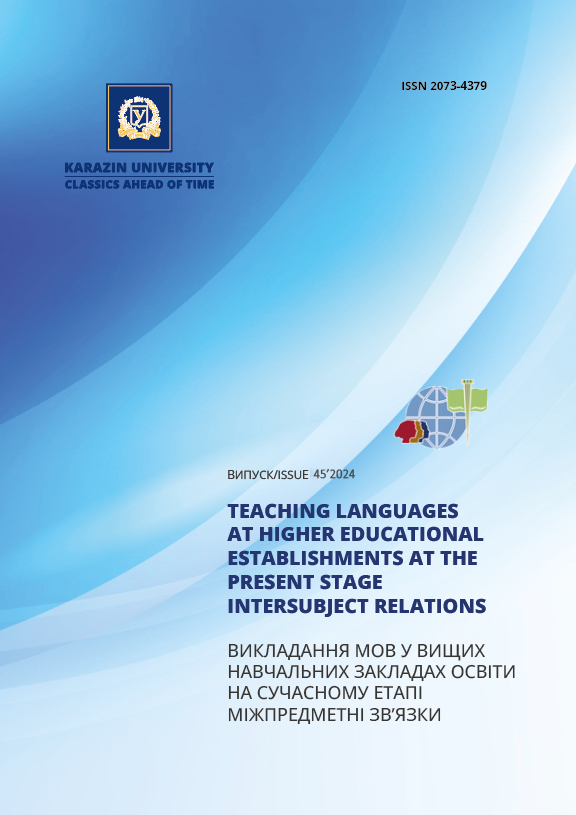Проблеми типології та перекладу українською мовою англомовних абревіатур у сфері навчання мов
Анотація
Стаття аналізує тематичні групи (ТГ) та підгрупи (ТПГ) англомовних абревіатур чотирьох категорій у сфері навчання мов: 1) назви організацій у сфері навчання мов; 2) назви підходів до навчання мов та форм його організації; 3) назви форм контролю, дипломів і сертифікатів у навчанні мов; 4) характеристика мов як об’єктів навчання та тих, хто їх вивчає. Базуючись на подібних дослідженнях тематичної класифікації українськомовних термінів у різних галузях, авторка зазначає недостатню кількість розвідок стосовно англомовних абревіатур, що, разом із необхідністю їх системної тематичної класифікації, дозволило обґрунтувати актуальність дослідження, метою якого є виявлення згаданих ТГ та ТПГ, визначення їх структурних характеристик і способів перекладу, а завдання включали відбір матеріалу дослідження, його аналіз, формулювання висновків та подальших перспектив. Відповідні поняттєві ознаки формують систему англомовної термінології, що включає сукупність лексем, об’єднаних за екстралінгвістичними властивостями. Критерієм виокремлення ТГ та ТПГ є денотативна ознака, що позначає реалії позамовної дійсності. Розподіл лексем на ТГ та ТПГ є важливим завданням вивчення термінологічної системи. Матеріалом дослідження послужили 435 абревіатур, відібраних з оригінальних англомовних джерел. ТГ і ТПГ у межах проаналізованих категорій мають різний ступінь розгалуженості й можуть налічувати від 1 до 7 груп та підгруп кожна, які, у свою чергу можуть бути поділені на ще менші групи. Це обумовлює розташування найчисельніших та найрозгалуженіших ТГ і ТПГ в центрі відповідної категорії, в той час як найменш чисельні ТГ і ТПГ знаходяться на периферії. Проаналізовані ТГ і ТПГ вирізняються за кількісним складом, структурними моделями, приналежністю до частини мови та принципами передачі англомовних скорочень українською мовою. Логічність і чіткість проаналізованих ТГ і ТПГ забезпечуються спільними поняттєвими ознаками їхніх компонентів, що надає відповідним ТГ та ТПГ тематичної цілісності. Згадані компоненти ґрунтуються на різних термінотворчих моделях, від яких гіпотетично може залежати спосіб перекладу абревіатури. У вивченні такої залежності в межах проаналізованих категорій 1-4, зокрема, і полягає перспектива подальших досліджень.
Завантаження
Посилання
Borodina, N.S. (2013). Main classification lines in the Ukrainian linguodidactics terminology. Terminological Bulletin. Kyiv, 2(1), pp. 145-149. Available at: http://dspace.nbuv.gov.ua/handle/123456789/51267 [Accessed 20 Okt. 2021] [in Ukrainian].
Bulletin of Lviv Polytechnic National University. Series “Problems of Ukrainian terminology. (2017). I. Farion (Ed.). Lviv: Vyd-vo Lvivskoi politekhniky [in Ukrainian].
Herasimova, O.M. (2016). Peculiarities of terms translation (on the example of the border discourse). Scientific Bulletin of the International Humanitarian University. Ser. Philology. 22, pp. 180-182 [in Ukrainian].
Karaban, V.I. (2004). Translation of English scientific and technical literature. Vinnytsia: Nova Knyha [in Ukrainian].
Koval, R., Tyravska, O. (2017). Problemy perekladu terminolohii reabilitatsii [Problems of translation of rehabilitation terminology]. Bulletin of Lviv Polytechnic National University. Series “Problems of Ukrainian terminology”. 869, pp. 39-46 [in Ukrainian].
Kozak, L.V. (2011). Thematic structure of Ukrainian technical terminology. Available at: h.p://ukrmova.com.ua/2011/Artcl15.pdf [Accessed 23 Apr. 2020] [in Ukrainian].
Lepekha, T.V. (2000). Lexico-semantic and word-formation and structural features of forensic terminology. PhD thesis. Dnipropetrovsk [in Ukrainian].
Terminological Bulletin. (2017). Collection of scientific papers of the Institute of the Ukrainian Language of the National Academy of Sciences of Ukraine. Ivaschenko, V.L. (Ed.). Kyiv: Instytut ukrainskoi movy NANU, 4 [in Ukrainian].
Khalinovska, L.A. (2009). Thematic groups for the designation of names of aircraft in Ukrainian. Ukrainian terminology and modernity: a collection of scientific works, pp. 176-179 [in Ukrainian]
Kharchuk, L.V. (2013). Thematic classification of Ukrainian electric power terms. Terminological Bulletin. Kyiv: Instytut ukrainskoi movy NANU, 2(2), pp. 72-77. Available at: http://dspace.nbuv.gov.ua/handle/123456789/51291 [Accessed 20 Oct. 2021] [in Ukrainian].
Chernovaty, L.M., Kovalchuk, N.M. (2020). Thematic classification of English abbreviations of the names of organisations in the field of language teaching. Bulletin of V.N. Karazin Kharkiv National University. Series: Romance and Germanic Philology. Methods of teaching foreign languages. 91, pp. 198-204. DOI: https://doi.org/10.26565/2227-8877-2020-91-21 [in Ukrainian].
Chernovaty, L.M., Kovalchuk, N.M. (2021). Thematic classification of English abbreviations of the names of forms of control, diplomas and certificates in language teaching. V.N. Karazin Kharkiv National University Bulletin. Series: Foreign Philology. Methods of teaching foreign languages. 94, pp. 87-95. DOI: https://doi.org/10.26565/2227-8877-2021-94-13 [in Ukrainian].
Chernovaty, L.M., Kovalchuk, N.M. (2021). Thematic classification of English abbreviations of the names of approaches to language teaching and forms of its organisation. V.N. Karazin Kharkiv National University Bulletin. Series: Foreign Philology. Methods of teaching foreign languages. 92, pp. 129-137. DOI: https://doi.org/10.26565/2227-8877-2020-92-18 [in Ukrainian].
Chorna, O.V. (2017). Principles of systematic analysis of Ukrainian tax terms. Terminological Bulletin. Kyiv: Instytut ukrainskoi movy NANU, 4, pp. 198-204 [in Ukrainian].
Shmatko, I.V. (2015). Features of the systematic organisation of Ukrainian beekeeping terms by thematic and lexical-semantic groups. Terminological Bulletin. Kyiv: Instytut ukrainskoi movy NANU, 3(2), pp. 198-210 [in Ukrainian].
Acronyms Related to TESL. Internet TESL Journal. Available at: http://www.Iteslj.org > acronyms [Accessed 24 Apr. 2024].
al-Qinai, J. (2007). Abbreviation and Acronymy in English Arabic Translation. Meta. 52(2), pp. 368-375. DOI: https://doi.org/10.7202/016082ar
Belda, J.R. (2004). Translating Computer Abbreviations from English into Spanish: Main Types and Problems. Meta. 49(4), pp. 920-929.
Fijo, Leуn, M.I., Fuentes Luque, A.A. (2013). Corpus-based Approach to the Compilation, Analysis, and Translation of Rural Tourism Terms. Meta. 58(1), pp. 212-226.
Gehenot, D. (1975). Le sigle, aperçu linguistque. Meta. 20(4), pp. 271-307.
Myers H. (1974). Some Abbreviations for Energy Units in France. Meta. 19(4), pp. 203-205. DOI: https://doi.org/10.7202/003685ar
Nicaise, L. (2011). On Going Beyond the Literal: Translating Metaphorical Conceptualizations in Financial Discourse. Meta. 56(2), pp. 407-423. DOI: https://doi.org/10.7202/1006184ar
Richards, J.C., Schmidt, R. (2010). Longman Dictionary of Language Teaching and Applied Linguistics. Bungay: Longman.
Rodríguez González, F. (1993). Morphovariation and Synonymy of Acronyms. Meta. 38(2), pp. 275-292. DOI: https://doi.org/10.7202/002941ar
The Common European Framework of Reference for Languages. (2018). Cambridge: Cambridge University Press.
Wakabayashi, J. (1996). Teaching Medical Translation. Meta. 41(3), pp. 356-365. DOI: https://doi.org/10.7202/004584ar

